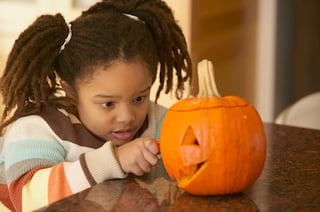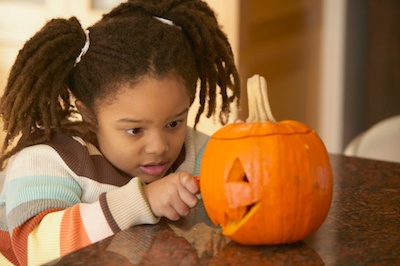 You want your young children to enjoy Halloween. To help ensure that happens, we’re sharing Halloween safety tips for kids to follow during (but not limited to) trick-or-treating time.
You want your young children to enjoy Halloween. To help ensure that happens, we’re sharing Halloween safety tips for kids to follow during (but not limited to) trick-or-treating time.
Time for Trick-or-Treat
When you take your children trick-or-treating, they are naturally excited, which means they may move in “unpredictable ways,” shares Akron Children’s Hospital. You don’t want children to dart into the street, so supervise them closely and consider providing them with glow sticks to light their way. Carry a flashlight yourself, especially important when trick-or-treating occurs where there are no sidewalks.
The article points out how bright, reflective costumes make good sense. Keep costumes short enough to prevent tripping, and ensure that your children wear shoes that fit well. You can add reflective tape to costumes for extra visibility, and that tape works well on trick-or-treat bags, too. Painting your child’s face eliminates the peripheral-vision problems masks can create. Check all elements of the costumes, including wigs and accessories, to make sure they are flame-resistant; the labels should indicate this.
Safe Kids provides more tips for a safe trick-or-treating experience, such as crossing streets at crosswalks or corners, preferably where there are traffic signals. If you see a brightly decorated house across the street from where you are walking, be especially alert as it can be very tempting for your children to want to cross the street right then and there. Keep the number of street crossings to a minimum, and instruct your children how they need to walk, not run, across the street.
It’s also important that you, as the supervising adult, don’t get distracted, so keep your electronic devices in your pocket or purse. If you need to drive your children to a trick-or-treat location or event, be very careful as you enter and exit driveways, alleys and parking lots. Pay extra attention at intersections and generally be very alert. Eliminate any unnecessary distractions, such as loud music in the car, so you can concentrate fully.
Tips for Home
Finally, the American Academy of Pediatrics offers the following tips at home. If your family plans to decorate pumpkins, make sure adults do all the cutting. Children can use markers to decorate the pumpkins and you can all brainstorm designs together — but no cutting for the young ones. You can use a glow stick inside the pumpkin for safer lighting; if you want to use a candle, votive candles are the safest choices. If you use a candle in your pumpkin, make sure you place the jack-o’-lantern where it can’t easily tip. Indoors, sturdy tables are the best choices, away from flammable objects such as curtains. Outside, make sure you are supervising all activity on the porch so the jack-o’-lantern doesn’t get knocked over.
When passing out treats at your own home, make sure your porch, steps and yard are clear of items that children could trip over; potential hazards range from toys to decorations to garden hoses and shovels. Put the porch light on (unless trick-or-treating happens in broad daylight) and make sure there aren’t any wet leaves or snow where a child could slip. If you have pets, put them in an area where they can’t jump on a trick-or-treater.
When trick-or-treating is over, inspect your own children’s candy to make sure nothing appears tampered with. If candy is unwrapped or otherwise looks suspicious or spoiled, throw it away. Better safe than sorry! And, finally, ration treats so your children don’t eat too much at any one time.




